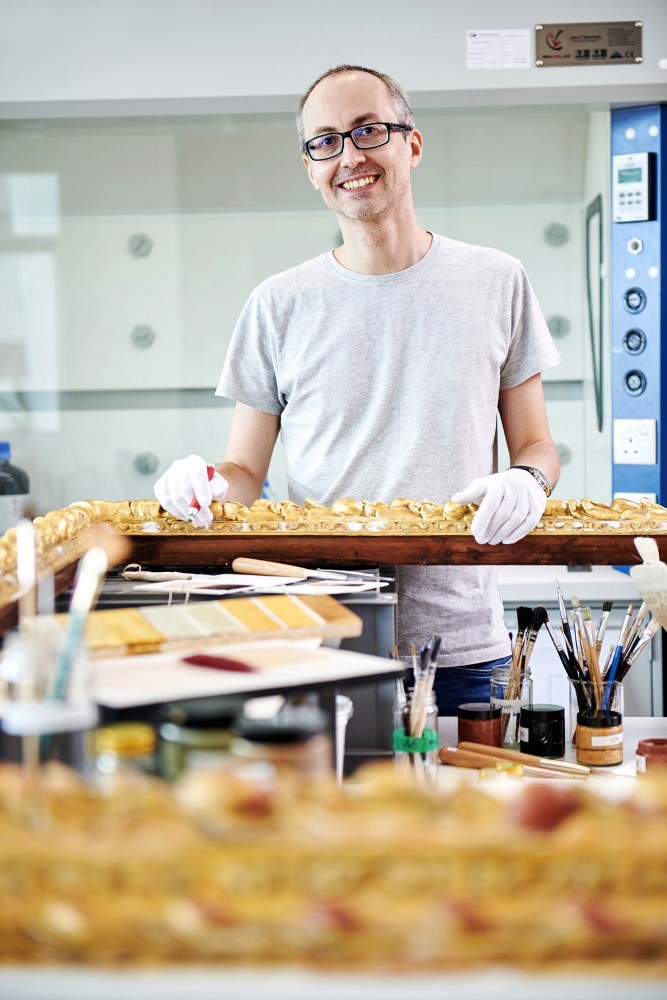MUSESG Volume 14 Issue 1 – July 2021
Text by Phua Xu Mei, Assistant Conservation Scientist
Read the full MUSE SG Vol 14. Issue 1
A silver flask from the Tang dynasty (618–907) was one of many luxurious metalware recovered from a shipwreck that had occurred over 1,100 years ago off Sumatra. Besides their opulent appeal, gold and silver vessels were also popular among the Tang elite because it was believed that drinking and eating from them would enhance one’s longevity.
This particular flask is notable for its large size and intricate workmanship. It is fully gilded, covered with the lush decoration of leaves and petals, and the handle is shaped like a snake. The pair of mandarin ducks on either side symbolise marital fidelity and harmony in traditional Chinese culture, as they are believed to mate with a single partner for life.
 A silver flask from the Tang dynasty uncovered from a shipwreck that had occurred more than 1,100 years ago. A symbol of opulence, the fully gilded flask features intricate workmanship, such as the lush decoration of leaves and petals, a handle shaped like a snake, and two mandarin ducks on either side. Flask with lid, Southern China, Tang Dynasty c. 830s, Collection of Asian Civilisation Museum
A silver flask from the Tang dynasty uncovered from a shipwreck that had occurred more than 1,100 years ago. A symbol of opulence, the fully gilded flask features intricate workmanship, such as the lush decoration of leaves and petals, a handle shaped like a snake, and two mandarin ducks on either side. Flask with lid, Southern China, Tang Dynasty c. 830s, Collection of Asian Civilisation Museum
During conservation, the flask was observed to have foreign material deposits on its surface. Scientific analysis was thus carried out to identify the deposits in order to determine what conservation work was needed—for example, whether the deposits should be removed or retained.
 Light-coloured, glossy deposit found on the flask’s underside.
Light-coloured, glossy deposit found on the flask’s underside.
Flask with lid, Southern China, Tang Dynasty c. 830s, Collection of Asian Civilisation Museum
A glossy light-coloured deposit found on the underside of the flask was identified as aragonite, a form of calcium carbonate found in the marine environment. Another dull brown substance found atop the flask’s base was identified to be an acrylic polymer. Since acrylic was only invented after the Tang dynasty, it was likely from later alterations. It is not uncommon to find non-original material on artefacts, as these could have accumulated from the environment or from previous repairs. They are reminders that artefacts require consistent conservation to withstand the test of time.
 Light-coloured, glossy deposit found on the flask’s underside.
Light-coloured, glossy deposit found on the flask’s underside.
Flask with lid, Southern China, Tang Dynasty c. 830s, Collection of Asian Civilisation Museum
 Brown substance found atop the flask’s base. Flask with lid, Southern China, Tang Dynasty c. 830s, Collection of Asian Civilisation Museum
Brown substance found atop the flask’s base. Flask with lid, Southern China, Tang Dynasty c. 830s, Collection of Asian Civilisation Museum
Being a conservation scientist, I am privy to the intricacies of artefacts up-close and can uncover their secrets—a very fortunate position, indeed. Information gleaned from analysis helps to tell the story behind an artefact, and as the writer Maya Angelou puts it: “There is no greater agony than bearing an untold story inside you.”




















